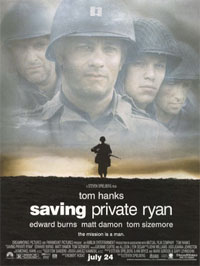Saving Private Ryan

Combat Footage
Contributing to the heightened sense of realism, Spielberg took an almost documentarian approach to filming "Saving Private Ryan." He did not do any storyboarding prior to shooting, and used hand-held cameras much of the time. "In that way, I was able to hit the sets much like a newsreel cameraman following soldiers into war," he offers.
To achieve a tone and quality that was not only true to the story, but reflected the period in which it is set, Spielberg once again collaborated with cinematographer Janusz Kaminski. "Early on, we both knew that we did not want this to look like a technicolor extravaganza about World War II, but more like color newsreel footage from the 1940s, which is very desaturated and low-tech," Spielberg says.
Kaminski had the protective coating stripped from the camera lenses, making them closer to those used in the '40s. "Without the protective coating, the light goes in and starts bouncing around, which makes it slightly more diffused and a bit softer without being out of focus," he explains. The cinematographer completed the overall effect by putting the negative through an additional process that extracted more of the color.
Another camera technique they applied was using 90-degree shutters, or even 45-degree shutters for many of the battle sequences, as opposed to today's standard of 180-degree shutters. Kaminski clarifies, "In this way, we attained a certain staccato in the actors' movements and a certain crispness in the explosions, which makes them slightly more realistic."
Spielberg was unflinching in his desire to depict the Omaha landing as it really happened. "Omaha Beach was a slaughter," the director recounts. "It was a complete foul-up: from the expeditionary forces, to the reconnaissance forces, to the saturation bombing that missed most of its primary targets. Given that, I didn't want to glamorize what had really happened, so I tried to be as brutally honest as I could."
After all the planning, preparations and rehearsals, the attention to authenticity down to the last detail worked its own magic. When Spielberg called "Action," the cast could not help but feel transported from a movie set to an event half a century past.
"The adrenaline rush was like nothing I had ever experienced on any other movie, because it was chaos as soon as you stepped out there," Tom Hanks remembers. "There were people falling and explosions going off around you, and it was not hard to imagine that the carnage was real, that it was caused by bullets and mortars and shells. There's terror in our eyes in some of those scenes, and rightly so, because we were genuinely scared...and we knew that it was all fake."
Edward Burns adds, "I'm really glad we shot the D-Day invasion at the beginning of the schedule because it changed the way we looked at every scene that followed it. Nobody was prepared for how horrific it really was, and you really got a sense of what those guys went through."
"Being out there that day on the Irish Sea in those boats gave me a sensation of what it must have been like for those men," says Barry Pepper. "My mind started to wander and I began to think about how afraid they must have been. They were so tired and soaking wet, and then they stepped off the boats and saw their pals dying all around them, and all they could do was crawl up those beaches."
"The miracle of D-Day was that in the chaos of the invasion, with the generals far away and most of the plans having gone awry, small groups of privates and non-coms and mid-level officers took the initiative and, at terrible personal risk, did what needed to be done," screenwriter Robert Rodat offers.
Noted historian and author Stephen E. Ambrose, who has written what many consider to be one of the definitive books on D-Day--D-Day: June 6, 1944: The Climactic Battle of World War II--is serving as a historical consultant on "Saving Private Ryan." He observes, "The film catches what happened exactly. It is, without question, the most accurate and realistic depiction of war on screen that I have ever seen, not only in terms of the action, but the actors look, act, talk, walk, bitch, argue and love one another exactly as the GIs did in 1944."
Leaving Ireland, the company relocated to England for the remainder of principal photography. The abandoned British Aerospace facility in Hatfield, Hertfordshire, some 45 minutes north of London, served as the production's English base camp. The buildings on the site provided offices and workshop space, and the grass fields became a perfect backlot. There, Tom Sanders and his team built a full-scale reproduction of a bombed-out French village, complete with a bridge spanning a river where the story reaches its climax for Miller and his men.
Working literally from the ground down, they began by digging an actual river, and then constructed a war-torn French town around it. Sanders had first crafted three-dimensional models of towns he had visited during location scouting. Then, using carving knives, he simulated bomb damage until he had obtained a realistic look, which he could subsequently reproduce in large-scale. By using models as opposed to two-dimensional drawings, Sanders was able to design nooks and alleyways that were then built into the sets, from which Spielberg could shoot from various angles. With careful art direction and planning, the one set became two different village backdrops for two pivotal battle sequences.
Dale Dye's military expertise again proved invaluable to the filmmakers in the planning and filming of the final combat scene. He was instrumental in mapping out a realistic battle plan, to which Spielberg added his own input to accomplish his vision.
In England, other principal locations included a wheat field in Marlborough, which became the Ryans' Iowa farm, and Thame Park, Oxfordshire, which provided the setting for several scenes, including an intense skirmish between Miller's squad and a German machine-gun nest.
Prev | Page 1 | Page 2 | Page 3 | Page 4 | Page 5 | Next
Notes
Although Stephen Ambrose is listed as a historical consultant for the film, he was not actively involved during the actual production. Numerous books of his were used as reference sources, but Ambrose himself was never directly contacted by the film's production staff.

